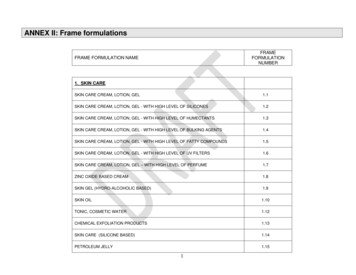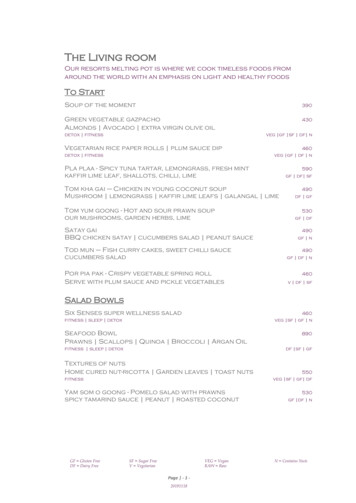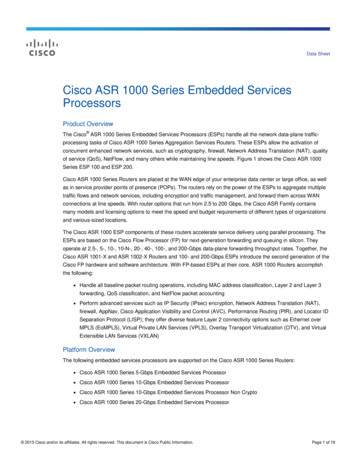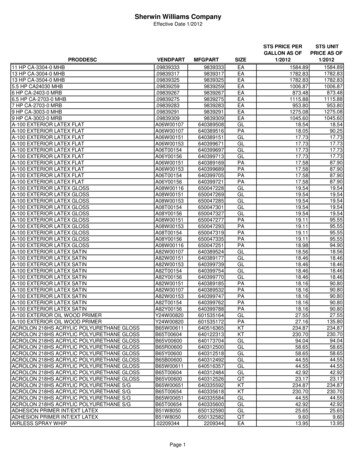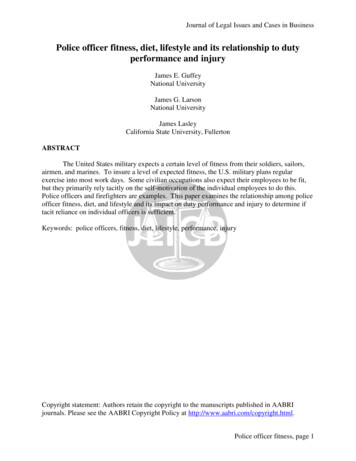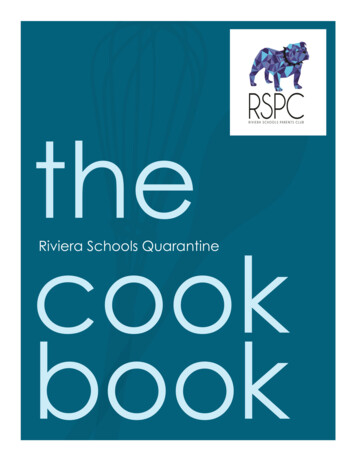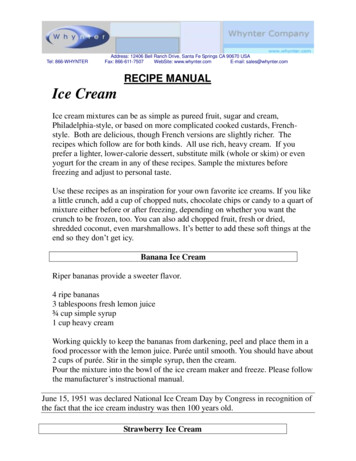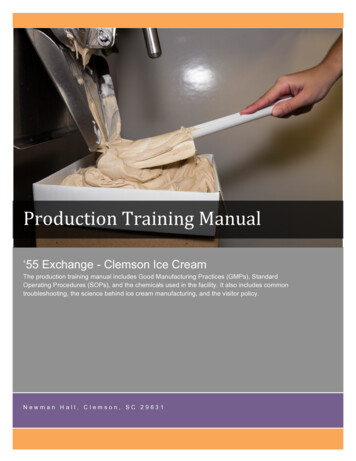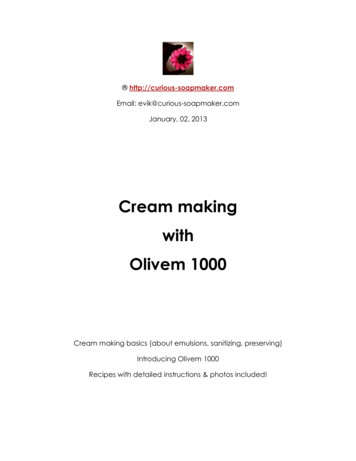
Transcription
http://curious-soapmaker.comEmail: evik@curious-soapmaker.comJanuary, 02, 2013Cream makingwithOlivem 1000Cream making basics (about emulsions, sanitizing, preserving)Introducing Olivem 1000Recipes with detailed instructions & photos included!
Making creams with Olivem 10002Table of ContentsI.Introduction . 3II.Cream making basics . 4II.1.What is cream (about emulsions and emulsifiers) . 4Emulsifiers . 5II.2.Making a cream/emulsion . 8II.3.Cream ingredients . 9II.4.What affects cream characteristics . 11II.5.Good practices or how to extend the product shelf life (about sanitizing,preserving and rancidity). 11Preserving mold/bacteria . 12Preserving rancidity . 14III.Olivem 1000. 15IV.My favorite Olivem 1000 recipes. 17Simple cream with vanilla and orchid. 18Protective anti-wrinkle cream with hyaluronic acid and coenzyme Q10 . 20Universal vanilla body butter with panthenol . 22Pregnant belly cream with rosehip oil . 25After shave with marigold . 26
3Making creams with Olivem 1000I.IntroductionI am not an Olivem 1000 distributor – as you can see, I do not sell any ingredients onmy website/blog - nor is this a sponsored advertisement.I just happen to use Olivem 1000 quite often in my formulations and was asked bymultiple friends to give them some guidelines on how to use it. Instead of writing itover and over again, I decided to put it on the paper and when this nicedocument was born, it was natural to share it with everyone interested.I hope you will find it useful, and will love to hear your feedback – just leave me acomment in my blog or send me an email!This document took some effort to write, so feel free to share it as is, or any part of it,under the condition you recognize my authorship and cite my blog, thanks!Disclaimer: I am not a licensed cosmetologist, physician, pharmacist or chemist. Allthe recipes and information contained in this document should be interpretedcarefully and used on your own risk and with regard to all your medical conditionsyou may have. I am not responsible for any action that can be taken based on thematerial and information in this document or for any possible consequences.
Making creams with Olivem 1000II.4Cream making basicsIf you have never made a cream(emulsion), please, read this sectionthoroughly.In the following subsections, I try to explainall the important basics for cream making. Ido not go to details on the characteristicsof oils, different water flowers, powders,actives, as this information can be foundpretty much elsewhere and would be outof scope.II.1. What is cream (about emulsions and emulsifiers)Cream is an emulsion – homogenous mix between water and oils.There are many types of emulsions, but the two we find in creams are water in oil(w/o) and oil in water (o/w) (Figure 1).W/O emulsions contain usually 10-35% of the oil phase and are the most common –e.g. day creams, body milks, etc. They are less greasy.O/W emulsions contain 45-80% of the oil phase and have more greasy feeling. Herebelong mainly cold creams, night creams, ointments.It might seem that it is the proportion of water to oils that makes the difference, butin reality it is more complicated and it depends on the type of emulsifier.Figure 1. Schematic representation of the oil in water (O/W) and water in oil (W/O) emulsion
5Making creams with Olivem 1000EMULSIFIERSWater and oils do not really like each other – worse – they are repulsed - andtherefore do not mix well (try to pour oil in some water and stir).An effort is needed to make them stick together and make the emulsion:mechanical and chemical.The mechanical one is the stirring – by hand, or better using blender. The strongerthe mixing, the finer the droplets will be created and the more stable the emulsionwill be.However, simple mechanical mixing does not make the emulsion stable in long termand under different temperatures.That is why a third guy needs to come to the party (I call him the icebreaker). Theicebreaker is a chemical molecule that has lipophilic and hydrophilic tail.This means it likes both oils and water and can connect them into a homogenousand stable emulsion (Figure 2)Figure 2. Schematic representation of the function of emulsifier in the oil in water emulsion.Emulsifier with hydrophilic (circle) and lipophilic (line) tails connects to water (blue) and oils (orange),creating small oil droplets.
Making creams with Olivem 10006The third guy is called emulsifier. There are many types of emulsifiers, you mighthave heard about the emulsifying wax, for example. The type of emulsion that anemulsifier creates can be estimated based on its HLB (hydrophilic-lipophilicbalance) value.Emulsifiers with low HLB value create W/O emulsions and emulsifiers with high HLBcreate O/W solutions.More on HLB: Wiki definitionThe HLB system – a time saving guide to emulsifier selection - bookBeeswax borax combination is used often used in US as a natural w/o emulsifier.I do not use borax, as here in Europe it cannot be easily found. Even if I found it, Iam not sure if I would use it as it was found to have a genotoxic effect and ispotentially harmful for reproductive organs. However, the evidence is rathercontroversial, many studies were provided on animals, lots are negative, some otherpositive.Lecithin is also an emulsifier. It does create nice emulsions, however mainly the w/o,greasy type of emulsion, that is liquid. Beeswax has to be added in order to obtaina thicker cream. Too much of lecithin gives the emulsion the characteristic lecithinodor and stickiness.Beeswax on its own is not a real emulsifier. As to my experience, it works foremulsions with more than 50% of the oil phase, however, its action is rathermechanical – by thickening it helps to stabilize the emulsion that is created bystrong mixingBeeswax and lecithin are good natural emulsifiers for w/o emulsions.The only easy-to-find/make and biodegradable emulsifier for o/w emulsions is soap.Yes, soap acts also as an emulsifier – this is how it cleans – it binds to the dirt(grease) by one tail of its molecule and the other one to the water – dirt is washedaway. However, soap based creams are often too basic (have high Ph, becausesoap cannot exist at Ph lower than 8, that is its nature, in lower Ph it decomposes)and can be irritating for skin.Therefore, in order to create lighter, less greasy or non-greasy O/W emulsions, weneed to use more elaborated emulsifiers, or also called emulsifying waxes.
7Making creams with Olivem 1000There are hundreds of commercial emulsifiers.For example TWEEN and SPAN 1: SPAN emulsifiers have low emulsifying HLB value,which means they create W/O emulsions and TWEEN emulsifiers have highemulsifying HLB value, creating rather O/W solutions. TWEEN are emulsifierscomposed of ethoxylated compounds and although these are considered safe foruse in cosmetics (according to a review from 2005 2), this is only under the conditionthe impurities and byproducts such as ethylene oxide and 1,4 dioxane areremoved. These two chemicals are considered carcinogenic3.The problem is that according to a report of the Environmental Working Group 4,5:“Although companies can easily remove it from ingredients during manufacture, testsdocumenting its common presence in products show that they often don't .”Some more reading about the ethoxylated compounds: versial/2011/1/22/ethoxylated-compounds.htmlThe most common emulsifying waxes for homemade cosmetics contain ethoxylatedemulsifiers (e.g. Polawax, Emulsifying wax NF contain PEG20 (PEG60 ), where PEGstands for ethoxylated polyethylene glycol).However, there has been a substantial effort in trying to find the non-ethoxoylatedalternatives and now there are many emulsifiers that are just simple esters of fatty acids(present in oils) and sugars or glycerin. Such an emulsifier is Olivem 8/19Claudia Fruijtier-Pölloth (2005) Safety assessment on polyethylene glycols (PEGs) and their derivatives asused in cosmetic products. Review. Toxicology. 214 (1–2), p.1–383 Julie A Stickney, Shawn L Sager, Jacquelyn R Clarkson, Lee Ann Smith, Betty J Locey, Michael J Bock, RolfHartung, Steven F Olp. (2003) An updated evaluation of the carcinogenic potential of 1,4-dioxane. RegulatoryToxicology and Pharmacology 38(2), p.183–1954 EWG warns of 1,4-dioxane in cosmetics. (2007) Focus on Surfactants 4, p. 45 sing-impurity12
Making creams with Olivem 10008II.2. Making a cream/emulsionTo make a cream, we have to make anemulsion. Here are the three basic steps.1) Heating the water and oil phase inseparate containers until 50 C or 70 CDifferent authors give differentrecommendations, I think highertemperature is better, because itmight help to kill some bacterias andbecause some of the emulsifiers andwaxes have higher melting point.This happens usually in water bath as you wish to avoid overheating, for twomain reasons:a. You will quickly evaporate part of your water phase and in case you usefloral waters, you could actually degrade/deactivate the goodies theycontainb. Some oils – good examples are shea butter and cocoa butter – becomeafter overheating grainy – not something you wish to experience in yourfinal formulationReason for this step: It was found that emulsion is easier to make when bothphases are at the same temperature and that somewhere between 50 C-70 Clies the renvers point that is crucial for the formation of an emulsion. Below thistemperature emulsion will not happen, unless special – cold emulsifiers are used.Tip: Cover your water phase while heating otherwise it will evaporate (even at70 C some water starts to evaporate)2) When both phases reach the desired temperature, take both containers off theheat and pour slowly the oil phase into the water phase, while continuouslystirring/blending.I did not find any reasoning why oil phase in the water phase, and in myexperience, pouring water in oil works as well.I know that for example Susan Barclay Nichols insists on using the heat&holdmethod, which means heating both phases and holding for 20 minutes at thedesired temperature and only after mix the phases together. While it might helpto kill some more bacteria that might be present, I did not find this method
9Making creams with Olivem 1000necessary in order to make the emulsion more stable over time or increasing theproduct shelf life. However, I did not make any elaborate experiments on thesubject (I might make), nor do I sell my products, so I cannot really make definiteclaims about it and I mention this method as a potentially interesting conceptfor everyone.Reason for this step: Why to heat both phases separately? That is a very goodquestion. I did not really find answer to this, but I think that it is because someemulsifiers need time to work and pouring one phase into another slowly makesit easier for them. With some emulsifiers heating both phases together mightwork pretty well – I have this experience with Olivem 1000. However, you mightneed the blender.Tip: If you are pouring oils to water, make sure your water container is largeenough to contain both phases.3) When emulsion takes place (somewhere in between 50 -70 C), continue stirringuntil the temperature drops below 50 C. At this point you may add all other, heatsensitive ingredients – such as preservative, fragrance, actives (hyaluronic acid,panthenol, coenzyme Q10 ).Mix well and then pour in containers.Reason for this step: Stirring until the emulsion cools down ensures the emulsionstability – in some cases if you cease stirring too soon, emulsion will separateupon cooling.Tip: Place your mixing bowl in cold water to speed the cooling.II.3. Cream ingredientsWhile an emulsion that is the main part of a creamconstitutes of oil phase, water phase and emulsifier,additional ingredients are added, mainly:-Fragrances/essential oilsColorantsPreservativesActives – in principle everything else that wasadded in order to have a desirable effect on
Making creams with Olivem 100010the skin, usually in small quantities – panthenol, hyaluronic acid, vitamins,hydrolyzed proteins, Majority of these additional ingredients are heat sensitive – which means can beeither evaporated or their function changed – therefore are added in the cooldown phase.Emulsifiers are often added to the oil phase when heating, as they are often moreoil than water soluble.Your cream will carry all the effects of the ingredients used. Instead of pure wateryou can use floral/herbal waters or infusions as your water phase. You can infuseyour oils with herbs (e.g. maringold) or vegetables (carrot).Adding fatty alcohols (cetearyl, cetyl alcohol) will add the product a good slip andglide. These should be dissolved in the oil phase.If you plan to add powders (e.g. zinc oxide in the natural deodorant that really –but really - works!), do not forget that they will absorb some of the water phase andthicken the cream. Adjust the cream consistency accordingly – by adding morewater and making more liquid emulsion.Tip: Pay attention on the compatibility of ingredients and possible negative effectsthat should be compensated for.For example grapefruit seed extract and xanthan gum are not compatible – createbizarre white strains in the final product, like on the picture of strawberry peeling Ihave made below:
11Making creams with Olivem 1000Other ingredients (including some emulsifiers) make the final product too basic(high Ph) and therefore a bit of citric acid should be added in order to lower the Ph.Or, some preservatives are active under different Ph conditions – again, theyhave to be chosen with regard to other ingredients.II.4. What affects cream characteristicsCream effect on skin definitely depends on itsingredients – see section II.3.The cream feeling depends on the: Proportion of oil vs. water phase and type ofemulsion (more oils and W/O emulsion usuallyresults in more greasy feeling)Type of oils used (e.g. lighter oils give lessgreasy creams)Type and proportion of emulsifier – each emulsifier has different properties,some of them can make cream more protective and waxy, other give morepenetrating emulsions. Amount of the emulsifier can important play role.Other additives – e. g. adding isopropyl myristate in the oil phase diminishesthe greasiness of each creamCream consistency depends on the: Type and proportion of emulsifier – some emulsifiers, like lecithin give mainlyliquid emulsions, others, like Olivem 1000 mainly thicker creams.Oil type – butters will give thicker creams than liquid oilsOther additives – adding beeswax or other waxes can thicken the creamOil vs. water phase proportion – this is dependent on the type of emulsifier,too - with some emulsifiers more water means lighter and more liquidemulsion, in others this does not matter much (e.g. lecithin or Olivem 1000)II.5. Good practices or how to extend the product shelf life (aboutsanitizing, preserving and rancidity)There are basically three things that can happen to your cream over time:-the water and oils will separate – choosing a good emulsifier for yourformulation can postpone this for years
Making creams with Olivem 1000-12it will grow bacteria/moldit will go rancidPREVENTING BACTERIA/MOLDBacteria and mold are everywhere and the last thing you wish is them using yournatural, handmade cream full of goodies as a food supporting their growth andexpansion.Both need water to grow; therefore this kind of contamination will occur in everyformulation that contains a water phase – in other words in any emulsion andtherefore cream.There are two main ways how to keep them out for as long as possible: Do not let them in:a) by sanitizing all your working area, tools and containers that you usewhile making cream (see below)b) by minimizing the contact between fingers and the formulationMake them not liking it:c) add preservativesa) Sanitizing your working area, tools and containersIt is boring, mainly when you have this super idea and you really want to start but necessary - unless you want your super formulation to get green from mold orchange its scent and color because of bacterial growth (not always traceable bythese changes).Choose one of the three methods: Boil the tools for 15 minutes in a distilled or soft water (if hard, calciumwill deposit on your tools):o No need to buy chlorine or alcoholo Not suitable for plastics that are not heat proof Use chlorine pastilles – just dissolve a chlorine pastille in wateraccording to instructions and soak in all your tools for 5 minuteso Effective
13Making creams with Olivem 1000o Need to dry – use paper towelsRub everything with 70% alcoholo Fast and easyo Difficult to reach all small places – soaking is betterb) Minimize the contact between fingers and cream Use clean spatulas instead of fingers to take the creamWhere possible, choose a container with a pump instead of wideopening cream containerc) Add preservativesThere are many options on the market, some considered more natural thanothers. For example Optiphen, Cosgard, Germall, Naticide.Different preservatives have different spectra of activity against differentbacteria and mold.Grapefruit seed extract was longtime considered a good naturalpreservative, but it seems its function was due to additional preservations added[REF]. I have been using it quite successfully and I do not mind that it might containother preservatives that do the job – mainly when I am out of stock of otherpreservatives.It seems that good preservatives are not natural and natural preservativesare not good [REF]. In any case:d) Always check your preservative compatibility with other components inyour formulation and follow the recommended percentage of usee) If you sanitized well your tools and avoid direct finger contact whenusing it, it can survive without preservatives if kept in refrigerator for amonth (own experience)f) While for yourself you can still try no-preservative formulations, if you sellor give away your products, do ALWAYS add a preservative. You haveno control how your friends/customers will stock and use your product.
Making creams with Olivem 100014PREVENTING RANCIDITYRancidity means decomposition of fatty acids into shorter molecules byoxidation. The short molecules have often distinctive and unpleasant odor and sodoes the rancid oil. Changes in color – mainly darkening – occur simultaneously.Rancidity is a potential problem of every formulation containing oil phase. Thisincludes creams.The oxidation shelf life of a formulation is the same as of the oil with the shortestshelf life in it, unless you added an anti-oxidant.Unsaturated fatty acids contain one or more double bonds between carbonatoms (Figure 3). Double bonds are easy to break by oxidation and thereforeunsaturated fatty acids are faster to go rancid than saturated (no double bonds)acids.Figure 3. Double bond between two carbon atoms in fatty acidsIn direct consequence oils containing mainly unsaturated fatty acids (these arealso liquid at room temperature) have shorter shelf life than oils containing mainlysaturated fatty acids (solid at room temperatures).In order to increase the shelf life of the formulation against rancidity followsthese three steps:a) Use only non-rancid and fresh oilsb) Add antioxidants. A typical example is Vitamine E (which is a mix oftocopherols).c) Keep your product in dark containers and in a cool place – warm andlight accelerate oxidation (this step is optional as usually the product isused up before this happen)
15Making creams with Olivem 1000III.Olivem 1000INCI: Sorbitan olivate & Glyceryl stearateOlivem 1000 is an emulsifying wax approved foruse in natural cosmetics formulations, EcoCertFrance certified and considered more naturalalternative emulsifying waxes containingethoxylated compounds.It is a self-emulsifying wax, what means it canbe used on its own, without the help of otheremulsifiers that would stabilize the emulsion.It is a mix of two components: sorbitan olivate – an ester of sorbitol (a sugar) and olive oil fatty acidscetearyl olivate – an ester of olive oil and cetearyl alcoholAlthough its production is industrial, it is considered an acceptable for naturalcosmetics, mainly.Its’ HLB is 9, although it is claimed that it does not act on the basis of HLB, but on thebasis of forming crystals.It is delivered in form of white pellets and has no distinctive odor.Usage: As to my experience, Olivem 1000 is good mainly for creating less-liquidcreams/emulsions.According to the excellent data sheet from aroma-zone.fr (please, use googletranslate from French to English, it is really worthy) the recommended usage rate isbetween 3-8%, where 3% gives light (but still not pourable) cream and 8% givesthick, more protective type of cream.Of course the resulting cream is dependent on the percentage of the oil phase inthe solution and type of oil used and the emulsion stability depends on Olivem 1000and oil phase proportion in the formulation (e.g. if we have 30% of oil phase, 3% ofOlivem 1000 in the formulation won’t create an emulsion)As to my experience, working with Olivem 1000 can be tricky – while it is withoutproblems if a blender is used, manual stirring can result in phase separation if notstirred until the emulsion cools below 28 C. I experienced this problem mainly afteradding cetyl alcohol. I think this is due to Olivem 1000 containing another fattyalcohol (cetearyl alcohol).
Making creams with Olivem 1000Some people find it little waxy, but this depends on the amount (more makescream waxier).16
17Making creams with Olivem 1000IV.My favorite Olivem 1000 recipesWhen making the recipes, feel free to change the types of oils and water phase(distilled water / mineral water / flower waters ).However, some of the oils have important function (for example rosehip oil inpregnant belly cream), so keep in mind that creams might change their effects andconsistency substantially (e.g. if adding)If you do not have some of the active ingredients from the cool down phase, justleave them out of the recipe.All the recipes are in % percentages. The easiest way to converting into grams orounces is just to substitute g or oz for the % sign, so 10% becomes 10g or 10oz.Of course, in ounces the recipes might become too large, so feel free to divide theamount accordingly (e.g. if a recipe counts for 100 oz, divide all quantities by 10 toget 10 oz recipe)
Making creams with Olivem 100018Simple cream with vanilla and orchidI was asked by a friend to make a simplecream with Olivem 1000 so that she knows,what does it feels like.And so I did it, trying to use only basicingredients that would not change ina substantial way the cream feeling andshow at maximum its. I had a vanilla infusionin sunflower oil and another friend broughtme from Thailand orchidea essential oil, soI used these.Recipe for 100g of creamOil phase (37%)20%Vanilla infusionin oil (in my caseit wasgrapeseed oil)10%Macadamia oil7%Olivem 1000Water phase (60%)60%MineralordistilledwaterCool down phase (3%)1.5%GSE –grapefruit seedextract (orotherpreservative)1%Vitamine E0.5%Orchid EOTip: You can use any combination of oils, as soon as they are at 30% of the recipeformulation.Instructions1) Sterilize your equipment, as instructed in the section II.5.2) In water bath heat the water phase to 70 C (158 F).3) At the same time, heat your oil phase until Olivem 1000 melts and the phasereaches 70 C (158 F).4) When both phases reach 70 C (158 F), take off the heat and add slowly the oilphase into the water phase while continuously stirring.IMPORTANT! 70 C is the temperature that ensures good emulsification. Lowertemperatures can cause separation of the two phases, higher temperatures wouldunnecessarily prolong the stirring time.
19Making creams with Olivem 10005) When emulsion occurs, place the bowl in cold water to accelerate cooling, whilestill stirring.6) When the temperature reaches 50 C (122 F), add the vitamine E, preservative andorchid EO. Higher temperature could inactivate one of the actives or thepreservative.
Making creams with Olivem 100020Protective anti-wrinkle cream with hyaluronic acid andcoenzyme Q10In this recipe, I tried to make selection of oilsthat are repairing (avocado oil, which is fullof phytosterols) and contain loads of antioxidants to protect our skin (carrot tissue oilcontains -carotens).However, because avocado oil is quitegreasy, I added fractionated coconut oilthat is very light, and absorbs well.The anti-wrinkle actives are hyaluronic acidand coenzyme Q10.To notice – hyaluronic acid creates a gelwhen mixed with water, and the final creamis somewhat glidy and takes longer be absorbed by skin.RecipeOil phase (29%)5%8%8%8%Water phase (68.2%)Carrot tissue oilAvocado oilFractionatedcoconut oilOlivem 100036% 6.8%25.5%MineralwaterRosewaterCool down phase (2.8%)1%Preservative1%Coenzyme Q100.3%0.5%Hyaluronic acidmixed withmineral waterrepresenting6.8% of therecipeformulationFragrance oil ofyour choiceInstructions1) Sterilize your equipment, as instructed in the section II.5.2) Mix well the hyaluronic acid (a white powder) with the amount of water representing6.8% of the recipe formulation. Pay attention to obtain smooth structure – add thepowder very slowly while intensly stirring. You shall obtain a transparent gel.
21Making creams with Olivem 10003) Add to this gel coenzyme Q10 and preservative.4) In water bath heat the rest of the water phase (36% 25.5%) to 70 C (158 F).5) At the same time, heat your oil phase until Olivem 1000 melts and the phase is at70 C (158 F).6) When both phases reach 70 C (158 F), take off the heat and add slowly the oilphase into the water phase while continuously stirring.IMPORTANT! 70 C is the temperature that ensures good emulsification. Lowertemperatures can cause separation of the two phases, higher temperatures wouldunnecessarily prolong the stirring time.7) When emulsion occurs, place the bowl in cold water to accelerate cooling, whilestill stirring.8) When the temperature reaches 50 C (122 F) you can add the phase prepared insteps 1-2. Stir in thorougly. Higher temperature could inactivate one of the actives orthe preservative9) At the very end add your fragrance – optional.Tip: If you do not have hyaluronic acid , add 13g of mineral water to the water phase.You can substitute oils for other, but this can affect the final greasiness.
Making creams with Olivem 100022Universal vanilla body butter with panthenol – when littlegoes a long wayI make this body butter regularly and am veryproud of it – originally I designed it as a creamfor my mother in law, who has dry skin. It was asuccess and fortunately – I left some for myselfto discover how perfect this cream is.It smells very gently of vanilla - thanks to vanillaoil infusion I have made (and do makeregularly) – Let macerate 1 vanilla pod in 100ml of oils – in this case I used macadamia oil –for a week.What I love about this cream is that it gives the perfect feeling and is less-greasy, thanksto the selection of the oils: macadamia oil and jojoba oil. At the same time I find it verynutritioning and repairing – thanks to the macadamia oil, avocado oil - that containsloads of phytosterols - and added panthenol (provitamine B5).The cethyl alcohol gives the butter the glide and slide – a silky, conditioning feeling. Itcan be used for face, hands or all over the body and a little of cream goes a long way!The oil composition makes it suitable for all skin types.In conclusion – this is the type of all purpose - all body – cream for all the family that willget used up before you know it. My darling uses it sometimes as an after shave whatcan I say more?
23Making creams with Olivem 1000RecipeOil phase (35%)10%10%5%7%3%Jojoba oilVanilla infusionin macadamiaoilAvocado oilOlivem 1000Cethyl alcoholWater phase (60%)61.5%Distilled waterCool down optional)Instructions1) Sterilize your equipment, as instructed in the section II.5.2) In water bath heat the water phase to 70 C (158 F).3) At the same time, heat your oil phase until Olivem 1000 melts and the phasereaches 70 C (158 F).4) When both phases reach 70 C (158 F), take off the heat and add slowly the oilphase into the water phase while continuously stirring.IMPORTANT! 70 C is the temperature that ensures good emulsification. Lowertemperatures can cause separation of the two phases, higher temperatureswould unnecessarily prolong the stirring time.
Making creams with Olivem 1000245) When emulsion occurs, place the bowl in
Making creams with Olivem 1000 2 Table of Contents I. Introduction . The only easy-to-find/make and biodegradable emulsifier for o/w emulsions is soap. Yes, soap acts also as an emulsifier – this is how it cleans – it binds to the dirt (grease) by one tail of its mol
